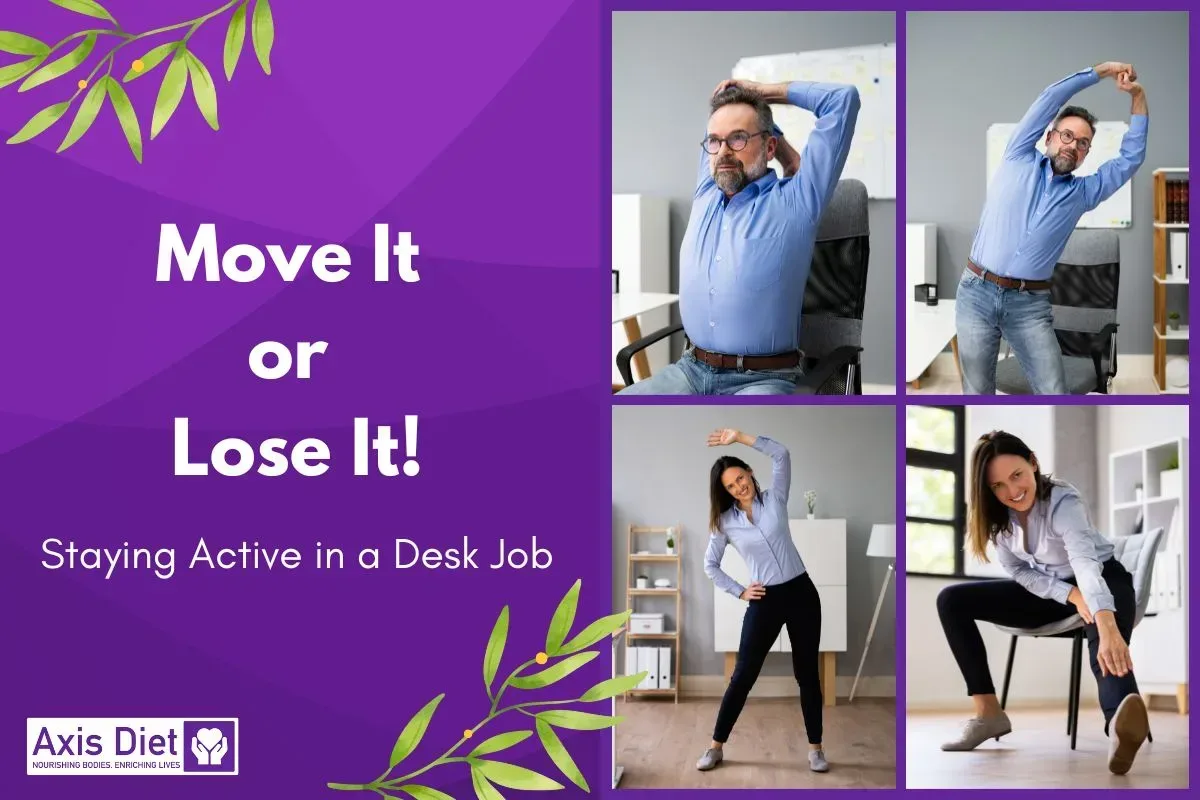In today’s digital age, a vast segment of the global workforce is anchored to their desk jobs, spending extended hours glued to computer screens. This trend of prolonged sitting, prevalent in both traditional offices and the booming work-from-home setups, underscores the need to stay active. At Axis Diet, our commitment is to arm our readers with life-changing knowledge. We’ll dive into the crucial role of embedding workouts into these lifestyles, the health implications of sidelining physical activity, and offer inventive strategies to stay active for those tethered to their desks.
The Imperative Need to Stay Active
Historically, our evolutionary journey has been one of constant motion. From hunting to migrating, our ancestors were always on the move. This intrinsic need for movement has been hardwired into our DNA. Explore the profound connection between exercise and mood in our article Workout for Stress Relief: The Science Behind Hormonal Balance.
- Mental Well-being
- Endorphin Release: Physical activity stimulates the release of endorphins. These are chemicals in the brain that act as natural painkillers and mood elevators. They’re often responsible for the ‘runner’s high’ that many athletes experience.
- Stress Reduction: Exercise reduces the levels of stress hormones in the body, such as adrenaline and cortisol. It also stimulates the production of dopamine and serotonin, neurotransmitters that regulate mood and behavior.
- Enhanced Productivity
- Brain Oxygenation: Physical activity increases blood flow, ensuring that the brain receives ample oxygen. This can sharpen cognitive functions and improve concentration.
- Break from Monotony: Short workout breaks can serve as a mental palate cleanser, breaking the monotony of continuous work and refreshing the mind.
- Posture and Ergonomics
- Spinal Health: Regular movement helps in maintaining the health of intervertebral discs, ensuring spinal flexibility and reducing the risk of disc herniation.
- Muscle Balance: Continuous sitting can lead to muscle imbalances. For instance, hip flexors can become tight, leading to lower back issues. Regular stretching can help counteract these imbalances.
The Consequences of a Desk Jobs
The sedentary nature of modern jobs has given rise to a plethora of health concerns:
- Cardiovascular Concerns
- Reduced Blood Flow: Sitting for extended periods can lead to reduced blood flow, increasing the risk of blood clots.
- High Blood Pressure: Lack of physical activity can result in weight gain, which is a significant factor in hypertension.
- Weight Gain and Obesity
- Metabolism Slowdown: Prolonged inactivity can slow down the metabolic rate, making weight management challenging.
- Insulin Resistance: Sedentary behavior can lead to increased insulin resistance, a precursor to Type 2 diabetes.
- Musculoskeletal Problems
- Joint Stiffness: Lack of movement can lead to joint stiffness, especially in the knees and hips.
- Muscle Atrophy: Muscles that aren’t used can weaken and shrink over time.
- Mental Health Issues
- Reduced Social Interaction: Especially in a work-from-home setup, prolonged sitting can reduce opportunities for social interactions, leading to feelings of isolation.
- Circadian Rhythm Disruption: Lack of physical activity can disrupt our natural sleep-wake cycle, leading to sleep disorders.
Workout Ideas for the Desk-Bound Jobs
Incorporating movement into a desk-bound routine might seem challenging, but with a bit of creativity, it’s entirely feasible:
1. Chair Squats
This exercise primarily targets the quadriceps, hamstrings, and glutes, promoting lower body strength and stability.
- Technique
- Begin by standing in front of your chair, feet shoulder-width apart.
- Extend your arms out in front for balance.
- Initiate the squat by pushing your hips back, as if you’re about to sit down.
- Lower yourself until your buttocks are just above the chair’s surface.
- Push through your heels to return to the starting position.
- Ensure your knees remain aligned with your toes and don’t jut out past them.
2. Desk Push-Ups
Desk push-ups are an excellent way to engage the chest, shoulders, and triceps, enhancing upper body strength without needing any equipment.
- Technique
- Stand a few feet away from your desk.
- Place your hands on the edge of the desk, slightly wider than shoulder-width apart.
- Keeping your body in a straight line from head to heels, lower your chest towards the desk.
- Push through your palms to return to the starting position.
- Ensure your core remains engaged throughout the movement.
3. Seated Leg Lifts
This exercise not only strengthens the quadriceps but also engages the core, promoting better posture and balance.
- Technique
- Sit at the edge of your chair, back straight, and hands holding the sides for support.
- Keeping one foot on the ground, lift the other leg straight out in front of you.
- Hold the lifted position for 5-10 seconds.
- Lower the leg back down and repeat with the other leg.
4. Stretching
- Neck Rolls
- Sit or stand with a straight posture.
- Slowly roll your head in a circular motion to the right.
- After a few rotations, switch and roll to the left.
- Ensure the movements are slow and controlled to avoid strain.
- Shoulder Shrugs
- Sit or stand upright.
- Lift your shoulders towards your ears, squeezing at the top.
- Hold for a few seconds and then release.
- Wrist Stretches
- Extend one arm in front of you with the palm facing up.
- With your other hand, gently press down on the fingers of the extended hand, stretching the wrist.
- Hold for a few seconds and then switch hands.
5. Walking
- Stair Climbing
- Find a set of stairs, preferably with a handrail for safety.
- Start at the bottom and climb to the top at a steady pace.
- Descend carefully and repeat as desired.
- Interval Walking
- Begin with a 5-minute warm-up at a relaxed pace.
- Increase your speed for a minute, walking as briskly as you can.
- Slow down and walk at a relaxed pace for another minute.
- Repeat the cycle for the duration of your walk.
Stay Active with New Work Routines
In the contemporary workspace, whether physical or virtual, the emphasis on health and well-being has never been more paramount. For those tethered to their desks or screens, integrating movement can be a challenge. However, with a sprinkle of creativity and a dash of commitment, it’s entirely feasible to merge fitness with work activities. Here are some innovative ideas to get you started:
1. Creative Daily Stand-Ups: Traditional stand-up meetings focus on discussing tasks. By introducing a ‘fitness leader’ role, each meeting becomes an opportunity for physical engagement. This role can rotate among team members, ensuring variety. For instance, one day might involve arm stretches, while another could focus on calf raises, ensuring different muscle groups are targeted throughout the week.
2. Fun Meetings with Movement: Meetings can sometimes be long and monotonous. By associating specific exercises with agenda points, participants remain alert and engaged. This method not only promotes physical activity but can also enhance cognitive function, leading to more productive discussions.
3. Walking Brainstorms: Walking has been shown to stimulate creative thinking. By turning brainstorm sessions into walking meetings, teams can benefit from fresh air and a change of scenery. For remote teams, walking while on a call can provide a break from the confines of home, leading to more vibrant and innovative discussions.
4. Monthly Workout Challenges: A bit of friendly competition can motivate even the most fitness-averse individuals. By setting monthly challenges and tracking progress, teams can bond over shared goals. Celebrating milestones, like completing a set number of squats or achieving a collective step count, can foster a sense of community and achievement.
5. Team Building with a Twist: Physical activities like dance or yoga not only promote health but also require coordination and cooperation. Organizing such sessions can enhance team cohesion, as members synchronize movements, learn new skills, and share laughs over inevitable missteps.
6. Task-Based Movement: By associating common tasks with specific exercises, employees can seamlessly integrate movement into their day. For instance, after every video call, one might do a set of chair squats. Over time, these actions become habitual, ensuring consistent physical activity throughout the day.
7. Deskercise Alarms: The dangers of prolonged sitting include increased risk of cardiovascular diseases and muscle stiffness. By setting hourly reminders, employees are prompted to take short breaks, stretching or doing quick exercises, which can mitigate these risks and boost energy levels.
8. Virtual Fitness Breaks: Remote work can sometimes lead to feelings of isolation. Organizing virtual fitness breaks not only promotes physical health but also provides social interaction. A 10-minute group stretching session or a quick workout challenge can break the monotony of the workday and strengthen team bonds.
9. Fitness Bingo: Gamification can be a powerful motivator. A Fitness Bingo card can include a mix of exercises and wellness tasks, like drinking water or meditating. As employees complete tasks, the competitive spirit can drive them to achieve a ‘bingo’, making fitness fun and engaging.
10. Dance Breaks: Music and dance are universal mood boosters. Introducing spontaneous dance breaks, especially during lengthy meetings, can rejuvenate participants. A quick 5-minute dance session can elevate spirits, improve circulation, and provide a much-needed mental break.
Incorporating such ideas can transform the work environment into a space that values health, camaraderie, and productivity. Embracing movement, even in small doses, can significantly enhance one’s quality of life and work output.
In Conclusion: Your Health, Your Responsibility
The modern work environment, with its conveniences and challenges, underscores the importance of proactive health management. While the tips and exercises provided are designed to guide you towards a healthier lifestyle, it’s essential to remember that each individual’s needs and circumstances are unique.
Before embarking on any fitness or nutritional journey, it’s always wise to consult with healthcare professionals. Registered dietitians, in particular, can offer personalized advice tailored to your specific dietary needs and goals. Their expertise can ensure that your path to wellness is both safe and effective.
Furthermore, understanding where you currently stand health-wise is crucial. The Body Mass Index (BMI) is a simple tool that provides insights into whether you’re underweight, at a healthy weight, overweight, or obese. We encourage you to use our BMI calculator to gain a clearer picture of your current health status. This knowledge can be the first step in your journey towards a healthier, more vibrant you.
At Axis Diet, we’re committed to empowering you with the tools and knowledge you need. Remember, your health is an investment, not an expense. Take charge, seek expert advice, and stride confidently towards a brighter, healthier future.






[…] exercise is not a mere act of burning calories or building muscles; it’s a profound journey into self-care, where the rhythms of the body and the harmonies of the mind unite in a symphony of well-being. […]
[…] the modern-day hustle, it’s easy to lose track of one’s physical activity levels. A fitness tracker eradicates this ambiguity, offering a clear picture of your daily, […]
[…] fortified products, and egg yolks into your diet, considering supplements if necessary, and staying active, you can effectively counteract the seasonal decrease in sun exposure. Remember, individual needs […]